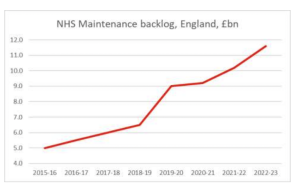New official figures show England’s NHS backlog of maintenance has rocketed by 13.6% in the last 12 months to a massive £11.6 billion. The annual Estates Returns Information Collection makes clear that this total is over and above what should be routine spending on maintenance and replacing/upgrading clapped out equipment:
“‘Backlog maintenance’ is a measure of how much would need to be invested to restore a building to a certain state based on a state of assessed risk criteria. It does not include planned maintenance work (rather, it is work that should already have taken place).”
The latest figure is more than double the 2016/17 figure of £5.5m, and has almost doubled in five years since the 2018/19 total of £6.5bn: it reflects the chronic lack of capital to maintain, let alone expand or improve England’s NHS after 13 miserable years of austerity funding.
And while around half (£3 billion) of the backlogs in 2018/19 were seen as ‘high’ or ‘significant’ risk, that proportion has now grown to 67% in the latest figures.
The Lowdown has calculated that £3.9 billion is classed as ‘high risk,’ which is defined as “where repairs/replacement must be addressed with urgent priority in order to prevent catastrophic failure, major disruption to clinical services or deficiencies in safety liable to cause serious injury and/or prosecution.”

Another £3.9 billion is in the next category, “significant risk,” “where repairs/replacement require priority management and expenditure in the short term so as not to cause undue concern to statutory enforcement bodies or risk to healthcare delivery or safety.”
Only a third of the total backlog is classified as moderate or low risk.
Four trusts now have “high risk” backlogs of more than £100m:
- Worst hit is Airedale FT, one of the hospitals in need of rebuilding due to the use of defective “RAAC” (‘reinforced autoclaved aerated concrete’) concrete, with almost the whole of the trust’s £353m backlog classed as “high risk”
- Imperial in North West London, where almost half (£319m) of the £769m total backlog is high risk relating to the crumbling St Mary’s Hospital (£145m) and the massive £174m maintenance backlog at Charing Cross Hospital (worsened by the 8 years of neglect while North West London health chiefs attempted to force through (subsequently abandoned) plans to close it down. Imperial also faces a £74m backlog at Hammersmith Hospital.
- Sixty percent (£102m) of Buckinghamshire Health Care’s £168m backlog bill is also “high risk” – most of this at Wycombe General Hospital (£84m)
- And over 60% (£106m) of Croydon’s £170m backlog is also high risk.
However some of the hospitals that have, like Airedale, been struggling to keep patients and staff safe in crumbling RAAC hospitals, have submitted much lower estimates this year for their backlog maintenance bills. For example in the 2019/20 returns, West Suffolk – a RAAC-riddled hospital so bad it was included in the original list of 40 promised new hospitals – bumped up its backlog to £635m: but in the most recent figures – despite the continued hiatus in beginning the long-promised new hospital, West Suffolk has apparently reduced its total estimated backlog to £113m.
Hillingdon Hospitals, for example, has inexplicably reduced its estimated backlog from £236m in 2019-20 to £153m in the latest figures.
 However Nottingham University Hospitals has seen a dramatic worsening in its state of repair, with its Queens Medical Centre now in need of £239m of repairs and upgrades, half (£121m) of which is either high or significant risk, out of a trust total backlog of £438m.
However Nottingham University Hospitals has seen a dramatic worsening in its state of repair, with its Queens Medical Centre now in need of £239m of repairs and upgrades, half (£121m) of which is either high or significant risk, out of a trust total backlog of £438m.
In the summer a National Audit Office report noted the combined England-wide backlog had rocketed in real terms from £4.7bn in 2013/14 to £10.2bn in 2021/22. Those figures showed 22 hospital trusts in England facing backlog maintenance bills in excess of £100m.
Now 29 trusts have topped the £100m mark, and it’s likely these numbers will continue to increase given the grossly inadequate level of capital funding.
An ITV News report earlier this year revealed that nearly half of NHS hospitals in England have been forced to close wards and vital services due to flooding, power cuts and structural problems.
Meanwhile, despite the warnings from the NAO, the mythical list of 48 “new hospitals,” seems no closer to being delivered than they were when first promised.
World class top-level ineptitude, which has proved a deadly combination with chronic cash starvation, has been demonstrated by the New Hospitals Programme’s recent advertising of a £600m (6 year) contract for consultancy support, while the NHP is also trying to recruit another “chief commercial officer” at a six figure salary … with so far not a business case completed or a single brick laid, which the costs of any possible projects continue to mushroom with cost inflation.
With spending on NHP consultancy services reaching the level that would pay for a new hospital, and still nothing to show for their labours, its role seems to have been reduced to acting as a human shield to distract attention from the lack of any actual building projects that had not been agreed long before any new hospitals were promised.
Dear Reader,
If you like our content please support our campaigning journalism to protect health care for all.
Our goal is to inform people, hold our politicians to account and help to build change through evidence based ideas.
Everyone should have access to comprehensive healthcare, but our NHS needs support. You can help us to continue to counter bad policy, battle neglect of the NHS and correct dangerous mis-infomation.
Supporters of the NHS are crucial in sustaining our health service and with your help we will be able to engage more people in securing its future.
Please donate to help support our campaigning NHS research and journalism.


